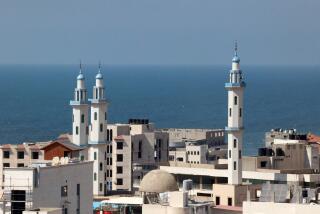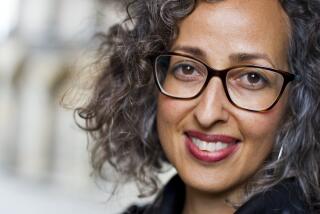Islam and Christianity’s war-peace-war-peace-war story
- Share via
Sea of Faith
Islam and Christianity in the Medieval Mediterranean World
Stephen O’Shea
Walker & Co.: 414 pp., $26.95
*
HISTORY is always relevant, although at certain times, certain moments in history may seem especially so. The centuries-long conflict between Christians and Muslims in medieval times rings obvious bells these days, as historian, journalist and translator Stephen O’Shea duly notes at the outset of his absorbing, crisply written chronicle “Sea of Faith”:
“[F]rom the seventh to the sixteenth century, Islam and Christianity would contend for primacy in the Mediterranean world.... At times acrimonious, at other times harmonious, the encounter between the two creeds in the Middle Ages provides a backdrop to much of what informs, and misinforms, public opinion on present-day conflicts.”
But if you’re expecting an argument on behalf of peaceful coexistence or, alternatively, a call to alarm on the order of Samuel P. Huntington’s “The Clash of Civilizations and the Remaking of World Order,” the colorful, if often gruesome, story that O’Shea narrates with considerable panache offers no easy answers to our current predicament. Wishing to distinguish his take on history from Huntington’s, O’Shea frequently draws attention to the positive aspects of this cultural interchange: the contributions of Muslim, Christian and Jewish poets, physicians, mathematicians and scholars during the periods of peace, tolerance and prosperity that occurred whenever La Convivencia replaced conflict.
But although few can deny the preferability of the former (a Spanish term meaning “intelligent coexistence of different communities of faith within the same state”) to the latter, the story told here also shows how difficult it was to achieve -- and, even more, to preserve -- this condition in a world rife with avarice, opportunism, thirst for conquest and endless squabbles both between and within the two contending proselytizing religions. Time and again, we are shown how inattentive, militarily unprepared countries (the original “soft targets”) fell victim to well-organized warriors motivated by cupidity, religious fervor or a combination of both.
Religion played a huge role in people’s lives then, as is evident in this comment by a visitor to 4th century Constantinople: “Everywhere, in humble homes, in the streets, in the marketplace ... one finds people talking about the most unexpected subjects. If I ask for my bill, the reply is a comment about the virgin birth; if I ask the price of bread, I am told that the Father is greater than the Son; when I ask whether my bath is ready, I am told that the Son was created from nothing.” But O’Shea is shrewdly perceptive about the motives often mixed in with faith: “Religious fervor, which the crusaders had in spades, did not preclude or even hinder worldly ambition. Faith may even have stoked it, the certainty of divine approval making the business of enriching oneself while eviscerating one’s enemy a saintly enterprise.”
O’Shea focuses on seven battles, beginning with the Muslims’ victory over the Byzantines at Yarmuk in 636 and ending with the Christians’ successful defense of Malta in 1565. More important, he fills in the background: in the case of Yarmuk, for example, the corruption and complacency of the Byzantines; and the determination and cohesiveness of the Arabs, united for the first time under the influence of the recently deceased Muhammad.
Military unpreparedness would continue to invite aggression. In 11th century Byzantium, incompetent rulers showered favors on favorites, drained the treasury and allowed wealthy landowners to consolidate their estates at the expense of the peasantry. As if to illustrate military historian Victor Davis Hanson’s point about small farmers being the backbone of a nation’s armed services, the Byzantine army dried up as these impoverished people, reduced to the status of serfs on the estates of the wealthy, were no longer able to meet their military obligations. Equally dangerous was the behavior of Byzantine Emperor Constantine IX Monomachus, a wonderfully cultivated “philosopher-king whose erudition and taste fostered a magnificent flowering of art and learning in the capital [but] proved disastrous in the more down-to-earth matter of protecting his empire,” disbanding a crucial army to spend that money on his courtly amusements.
Along with war, conflict and mayhem, O’Shea also portrays the oases of tolerance, prosperity and learning that sprang up in places like Muslim-ruled Cordoba and Constantinople and Christian-ruled Palermo and Toledo. Indeed, in some instances, conquerors like Palermo’s Norman rulers or Constantinople’s Ottomans -- who first used warlike methods to take over and establish control -- would later set about fostering a larger, more diverse and diversely skilled population to enhance the prosperity, cultivation and splendor of their cities.
Even more fascinating is the story of Cordoba’s first emir, Abd al Rahman I, who fled to Spain from his native Syria in the 8th century, the only member of the Umayyad caliphate to escape the brutal massacre perpetuated by its rivals, the Abbasids. The realm he established proved to be one of the Middle Ages’ high-water marks of civility, culture and even agriculture.
Yet this book also reminds us of the extent to which history and civilizations rest upon military foundations. “We take for granted the confessional geography of the Mediterranean, that is, which countries are, in their majority, Muslim or Christian,” O’Shea notes. “Yet there was nothing inevitable about Turkey being overwhelmingly Muslim, or Spain being overwhelmingly Christian. This geography of belief was decided in the millennium of the Middle Ages, through the contingencies of battle and the actions of men.”
The author of a book on World War I and another on the persecuted medieval sect known as the Cathars, O’Shea does a splendid job of making the long, complicated story he tells in “Sea of Faith” vivid and accessible. Helpful maps, excellent notes, a glossary, an index, a timeline, a bibliography and a list of central figures make it easy to follow what’s going on, while the text is enhanced by well-chosen photographs of the locales and well-chosen quotations from poets, male and female, Christian, Muslim and Jewish, who gave voice to the many passions, beliefs and mores of their eras.
*
Merle Rubin is a critic whose work has appeared in several publications, including the Wall Street Journal and the Christian Science Monitor.
More to Read
Sign up for our Book Club newsletter
Get the latest news, events and more from the Los Angeles Times Book Club, and help us get L.A. reading and talking.
You may occasionally receive promotional content from the Los Angeles Times.






